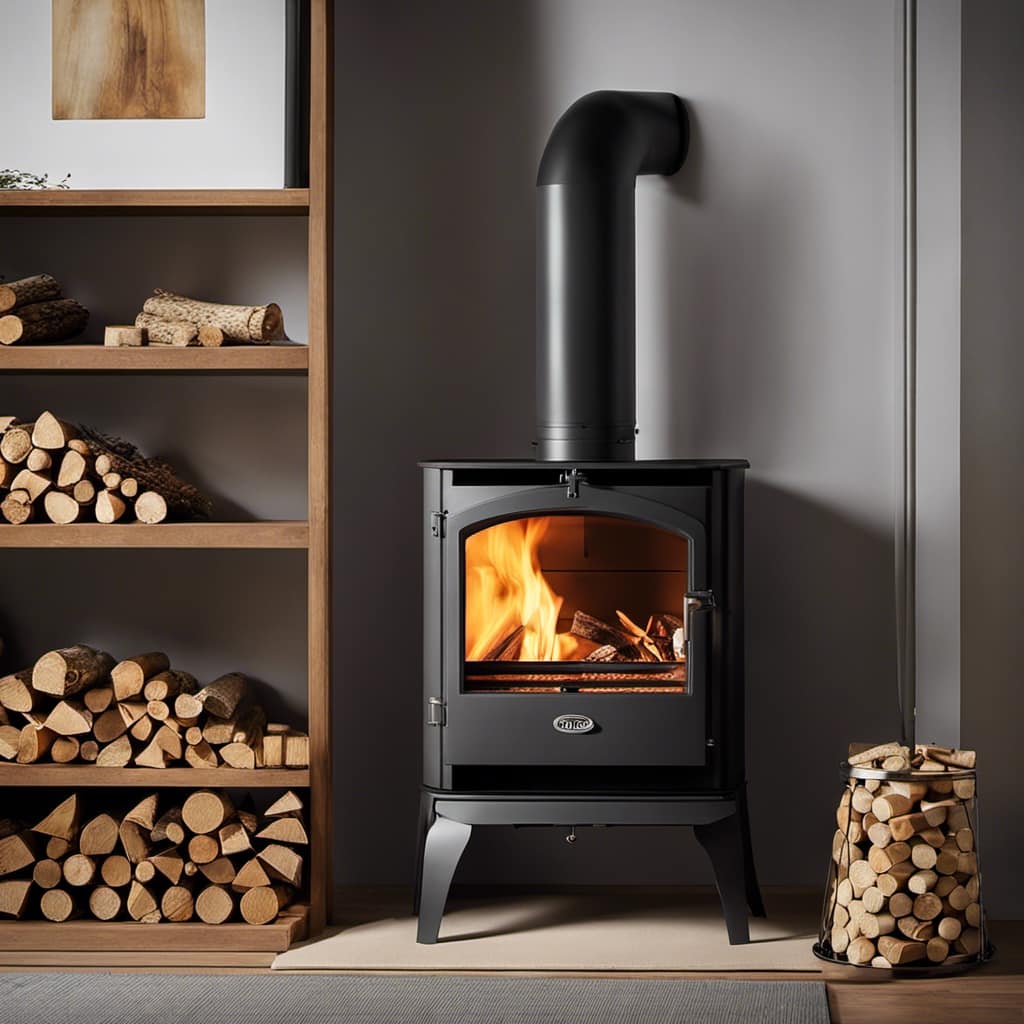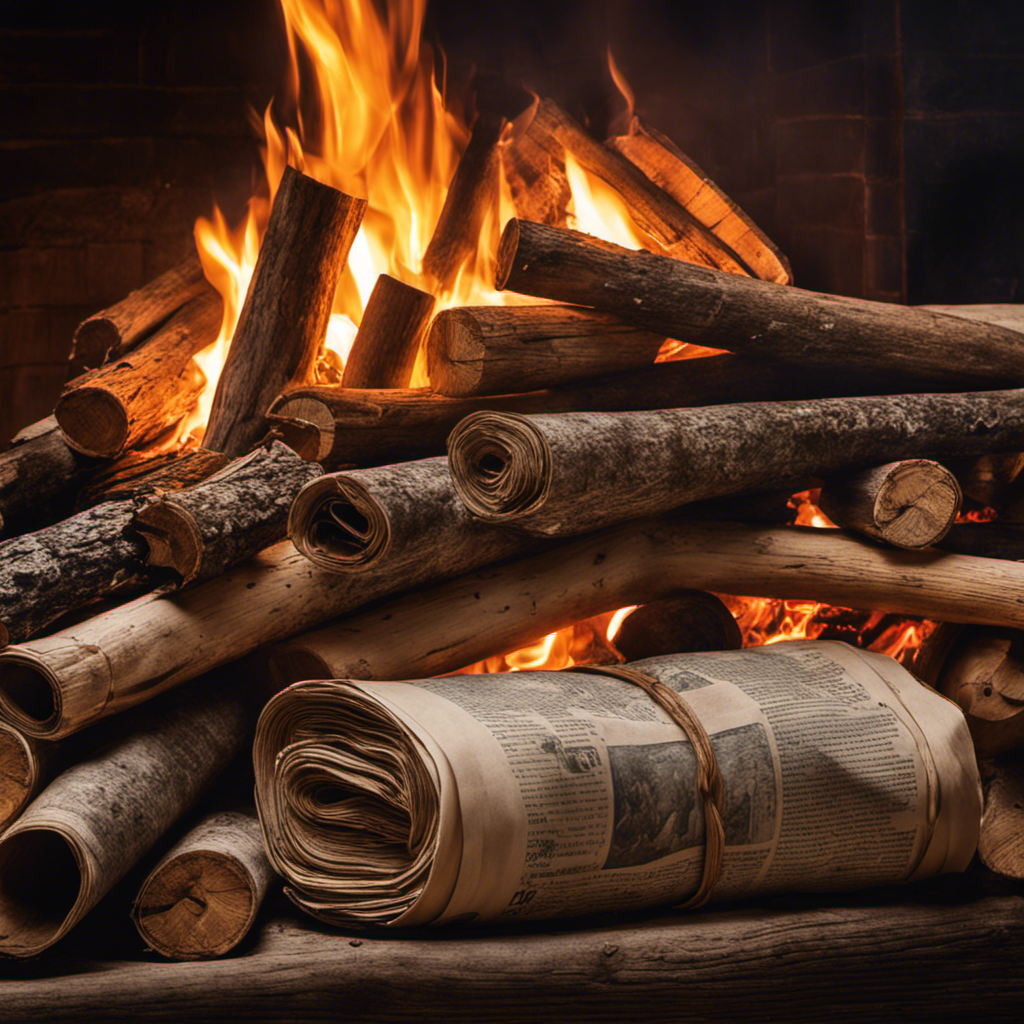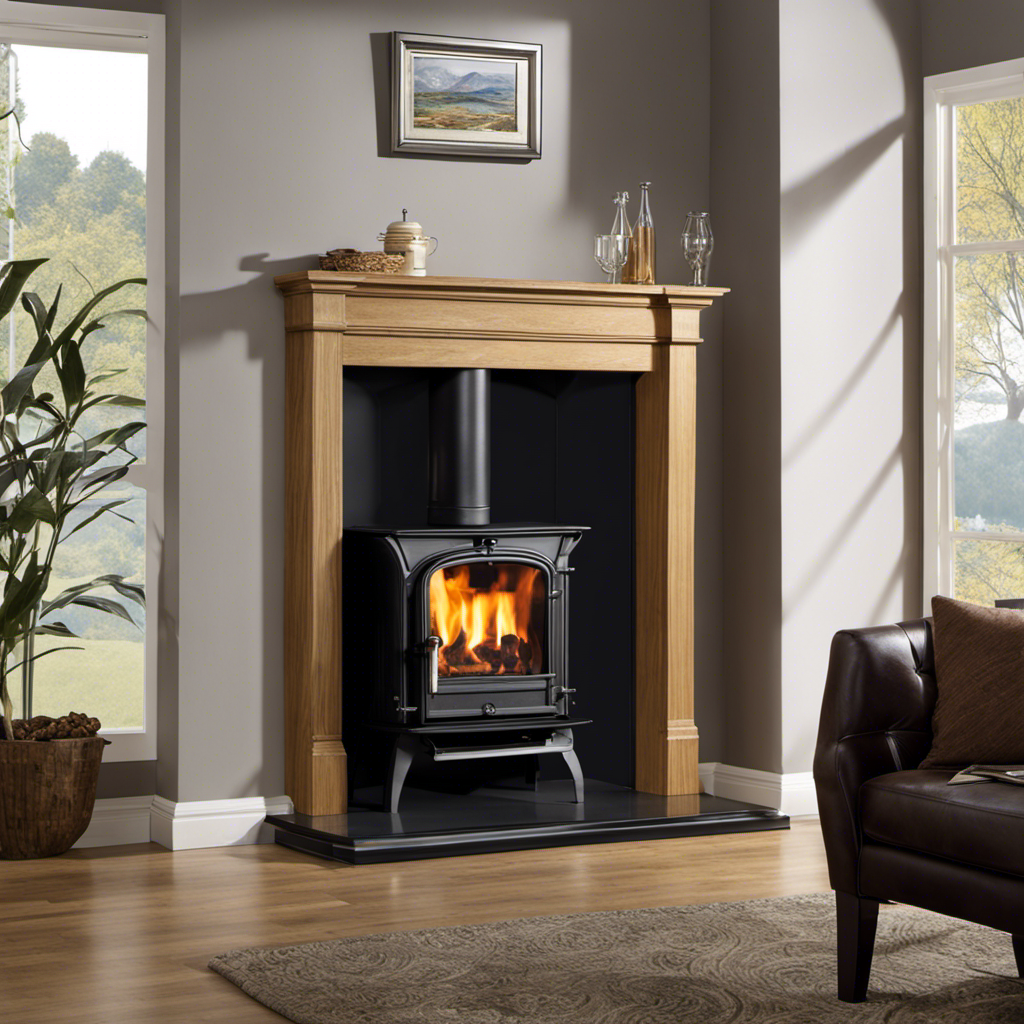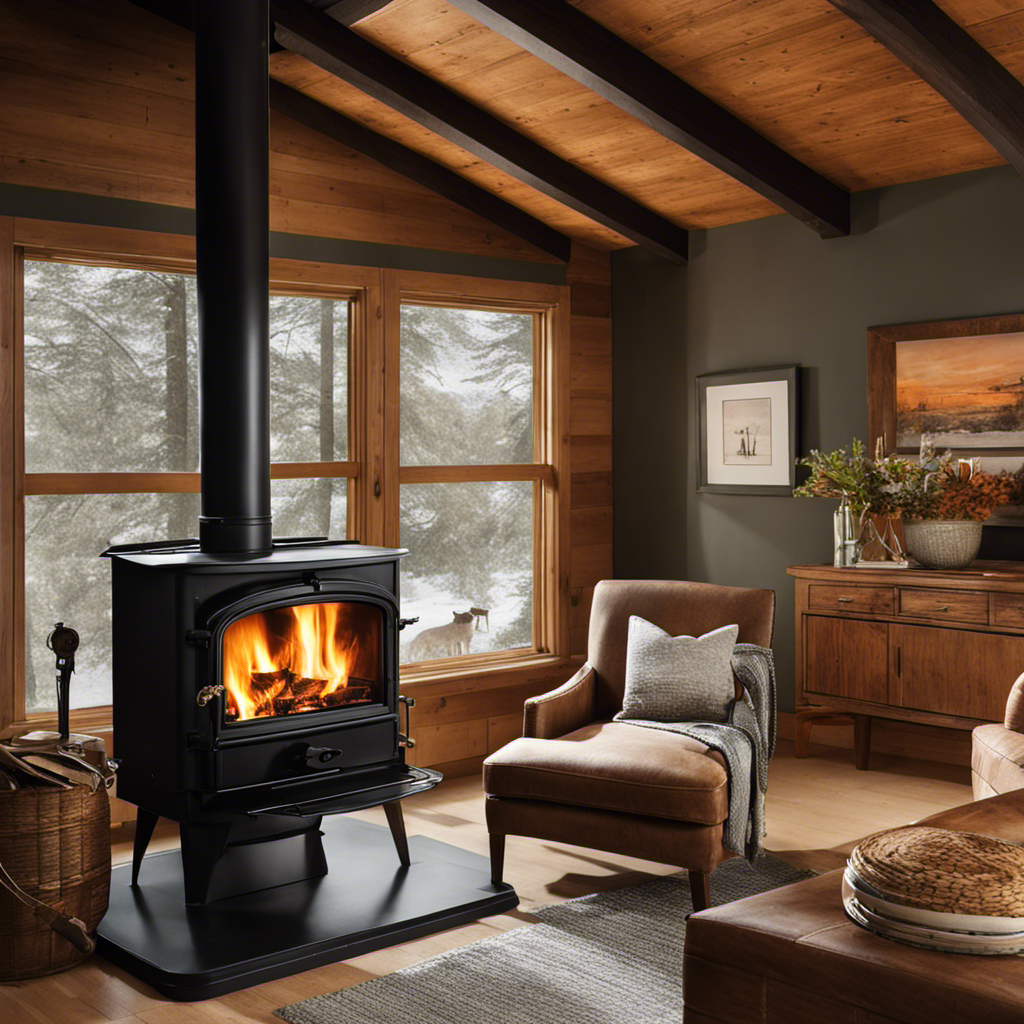Looking at the gently flickering flames in my wood stove, I am captivated by the charm of its glass doors. Yet, over time, those doors can gather soot and dirt, blocking the view.
But fear not! I’ve discovered a few tried and true methods for keeping those glass doors sparkling clean. From a simple vinegar and water mixture to a trusty baking soda paste, I’ll share with you the best ways to restore the clarity of your wood stove glass doors.
Key Takeaways
- Baking soda paste is a safe and efficient option for cleaning wood stove glass doors.
- Vinegar and water mixture can be used to dissolve dirt and grime on wood stove glass doors.
- Homemade cleaning solutions like vinegar and water or lemon juice and water are cost-effective and environmentally friendly alternatives.
- Commercial glass cleaners are readily available and can save time and effort compared to homemade solutions.
Natural Cleaning Solutions
I’ve found that using just three simple ingredients – vinegar, water, and baking soda – creates an effective and natural cleaning solution for tackling tough stains on glass doors. Homemade glass cleaner isn’t only a cost-effective option, but it’s also environmentally friendly, making it a win-win solution for keeping your glass doors spotless.
To make this homemade glass cleaner, start by mixing equal parts vinegar and water in a spray bottle. Vinegar acts as a natural degreaser and helps to dissolve dirt and grime. Then, add a teaspoon of baking soda to the mixture. Baking soda works as a gentle abrasive, helping to remove stubborn stains without scratching the glass surface. Shake the bottle well to combine the ingredients.

When using this eco-friendly cleaning option, spray the solution onto the glass surface and let it sit for a few minutes. Then, use a microfiber cloth or sponge to wipe away the dirt and grime. Rinse the glass with clean water and wipe it dry with a lint-free cloth for a streak-free shine.
Vinegar and Water Mixture
After mixing equal parts vinegar and water, I sprayed the mixture onto the glass surface and let it sit for a few minutes. The vinegar benefits in this homemade cleaning solution are remarkable.
Here are some key points about using vinegar and water mixture for cleaning:
- Vinegar is a natural disinfectant that kills germs and bacteria, making it an effective cleaner for glass surfaces.
- It helps to remove tough stains and grime without leaving any residue behind.
- Vinegar is safe to use and doesn’t contain harsh chemicals, making it an eco-friendly option.
- The acidic nature of vinegar helps to break down mineral deposits, making it ideal for cleaning glass doors.
- It’s cost-effective and readily available in most households.
Using the vinegar and water mixture is a simple and effective way to keep your glass surfaces clean and shiny. Give it a try and experience the benefits of this homemade cleaning solution.

Baking Soda Paste
To make a baking soda paste, mix one part water with three parts baking soda until it forms a thick consistency.
Baking soda is a versatile household ingredient that can be used for various cleaning techniques. When it comes to homemade remedies for cleaning, baking soda is a popular choice due to its effectiveness and affordability.
The paste can be used to clean a variety of surfaces, including wood stove glass doors. Simply apply the paste onto the glass and gently scrub it using a soft cloth or sponge. The baking soda acts as a gentle abrasive, removing dirt and grime without scratching the glass.
Rinse the glass with water and wipe it dry to reveal a clean and shiny surface. Baking soda paste is a safe and efficient way to clean wood stove glass doors, ensuring a clear view of the fire.

Commercial Glass Cleaners
I prefer using commercial glass cleaners because they offer convenience and efficiency in keeping my glass surfaces spotless. There are several reasons why commercial glass cleaners are my go-to choice for glass cleaning:
- They’re specifically formulated for glass surfaces, ensuring effective and streak-free cleaning.
- Commercial glass cleaners often contain powerful ingredients that can remove tough stains and grime.
- These products are readily available in stores and online, making them easily accessible.
- Using commercial glass cleaners saves me time and effort compared to making my own cleaning solutions.
- Many commercial glass cleaners also leave a protective coating on the glass, which helps to repel dirt and smudges.
While commercial glass cleaners are my preferred choice, I understand that some people prefer DIY approaches. In the next section, we’ll explore some popular DIY glass cleaning recipes and their effectiveness.
DIY Glass Cleaning Recipes
I’ve tried a few DIY glass cleaning recipes, but my favorite is a mixture of vinegar and water. It’s a simple and effective solution that can easily be made at home. Vinegar is a natural cleaning agent that helps to dissolve dirt and grime on glass surfaces. When combined with water, it creates a powerful yet gentle cleaner for windows, mirrors, and glass doors.
Here is a table comparing different DIY glass cleaning hacks:

| Recipe | Ingredients | Method |
|---|---|---|
| Vinegar and Water | – White vinegar – Water |
1. Mix equal parts vinegar and water 2. Pour the solution into a spray bottle 3. Spray onto the glass surface 4. Wipe clean with a lint-free cloth |
| Lemon Juice and Water | – Lemon juice – Water |
1. Squeeze fresh lemon juice 2. Mix equal parts lemon juice and water 3. Apply the solution to the glass 4. Wipe off with a microfiber cloth |
| Rubbing Alcohol and Water | – Rubbing alcohol – Water |
1. Mix equal parts rubbing alcohol and water 2. Dip a cloth into the solution 3. Gently scrub the glass 4. Wipe clean with a dry cloth |
These homemade window cleaner recipes are cost-effective and environmentally friendly alternatives to commercial glass cleaners. They can effectively remove dirt, fingerprints, and smudges from glass surfaces, leaving them sparkling clean. Give them a try and see which one works best for you!
Frequently Asked Questions
How Often Should I Clean My Wood Stove Glass Doors?
I clean my wood stove glass doors every 1-2 weeks to prevent residue buildup. To maintain clear and clean doors, I use a mixture of vinegar and water, or a specialized glass cleaner designed for wood stoves.
Can I Use Regular Household Glass Cleaners on My Wood Stove Glass Doors?
Can I just use any old glass cleaner on my wood stove glass doors? Ha! Not a chance. You’ll want to avoid harsh chemicals and opt for a natural cleaner like vinegar to prevent build up.
Are There Any Alternative Cleaning Methods That Don’t Involve Chemicals?
There are alternative cleaning methods for wood stove glass doors that don’t involve chemicals. Natural cleaning solutions, like vinegar and baking soda, can be effective in removing dirt and grime.

What Should I Avoid Using on My Wood Stove Glass Doors That Could Cause Damage?
I should avoid using harsh chemicals on my wood stove glass doors as they can cause damage. Instead, I can use gentle cleaning agents specifically designed for glass surfaces to safely and effectively clean them.
Is It Necessary to Remove the Glass Doors From the Wood Stove in Order to Clean Them Properly?
No, it’s not necessary to remove the glass doors from the wood stove to clean them properly. There are effective techniques for cleaning wood stove glass doors without removing them, which I’ll share with you.
Conclusion
After exploring various natural cleaning solutions and commercial glass cleaners, it’s clear that maintaining the cleanliness of wood stove glass doors can be achieved effortlessly.
By utilizing ingredients like vinegar, baking soda, or store-bought glass cleaners, one can effectively remove dirt and soot buildup.

With these simple yet effective cleaning methods, you can ensure that your wood stove glass doors remain clear and enhance the overall aesthetic appeal of your home.
Growing up surrounded by the vast beauty of nature, Sierra was always drawn to the call of the wild. While others sought the comfort of the familiar, she ventured out, embracing the unpredictable and finding stories in the heartbeat of nature.
At the epicenter of every remarkable venture lies a dynamic team—a fusion of diverse talents, visions, and passions. The essence of Best Small Wood Stoves is crafted and refined by such a trio: Sierra, Logan, and Terra. Their collective expertise has transformed the platform into a leading authority on small wood stoves, radiating warmth and knowledge in equal measure.











